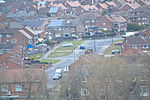Braithwell

Braithwell is a village and civil parish in the Metropolitan Borough of Doncaster in South Yorkshire, England. It is about 1 mile (1.6 km) north from Maltby and 3 miles (5 km) south-east from Conisbrough. According to the 2001 Census the civil parish had a population of 1,056, increasing slightly to 1,060 at the 2011 Census.In 1289, the village obtained a Royal Charter entitling it to hold a weekly Tuesday market and an annual eight-day fair – an unusually long duration. These were long discontinued by a survey of 1652, but a cross shaft survives with an inscription in Norman French which translates as "Jesus, son of Mary, think upon the brother of our king, I beseech you".The Church of St James in the village is a Grade II* listed building.
Excerpt from the Wikipedia article Braithwell (License: CC BY-SA 3.0, Authors, Images).Braithwell
High Street, Doncaster Braithwell
Geographical coordinates (GPS) Address Nearby Places Show on map
Geographical coordinates (GPS)
| Latitude | Longitude |
|---|---|
| N 53.446 ° | E -1.20179 ° |
Address
High Street
High Street
S66 7AW Doncaster, Braithwell
England, United Kingdom
Open on Google Maps







